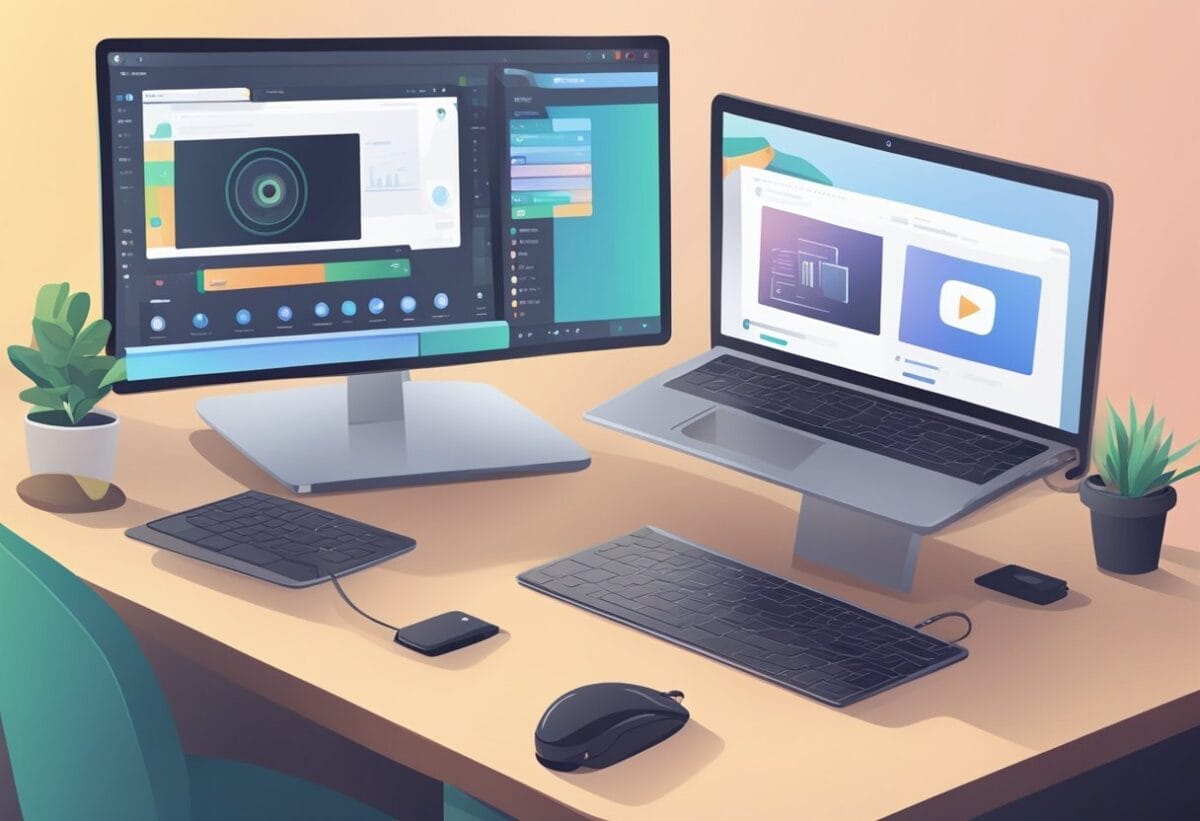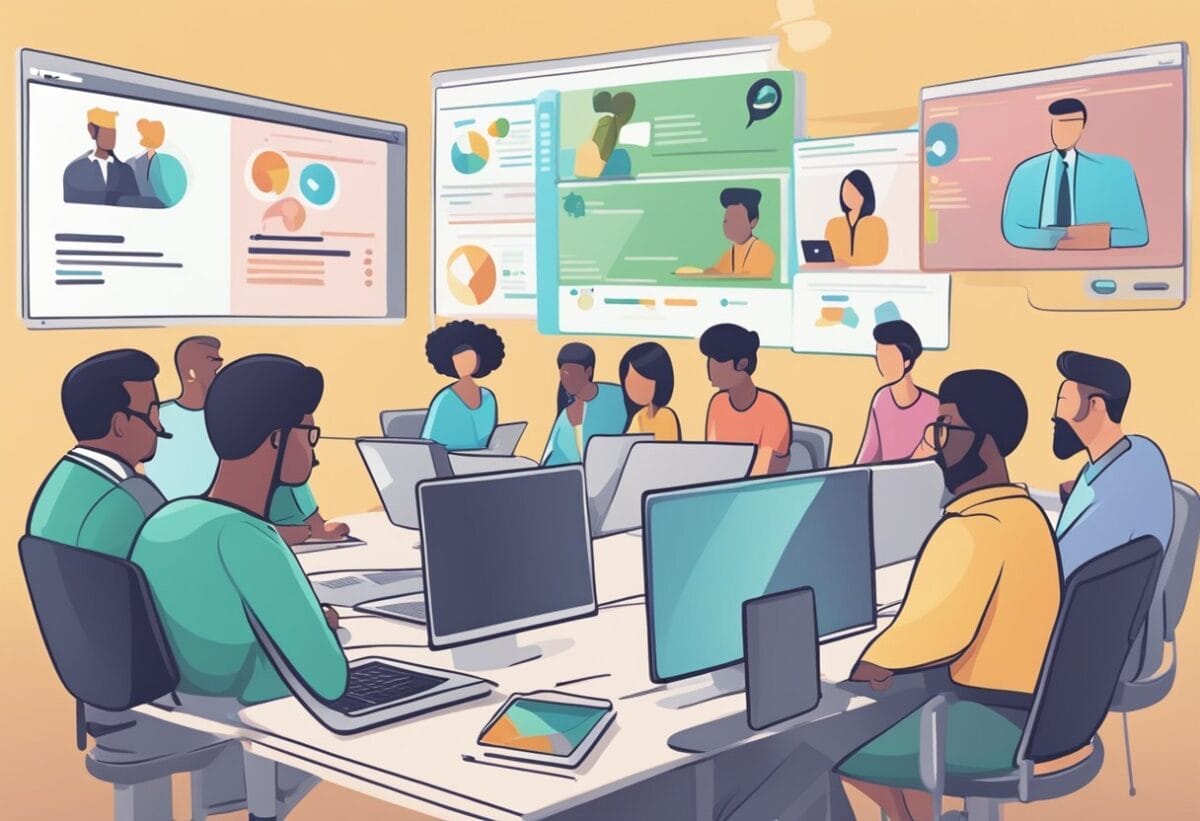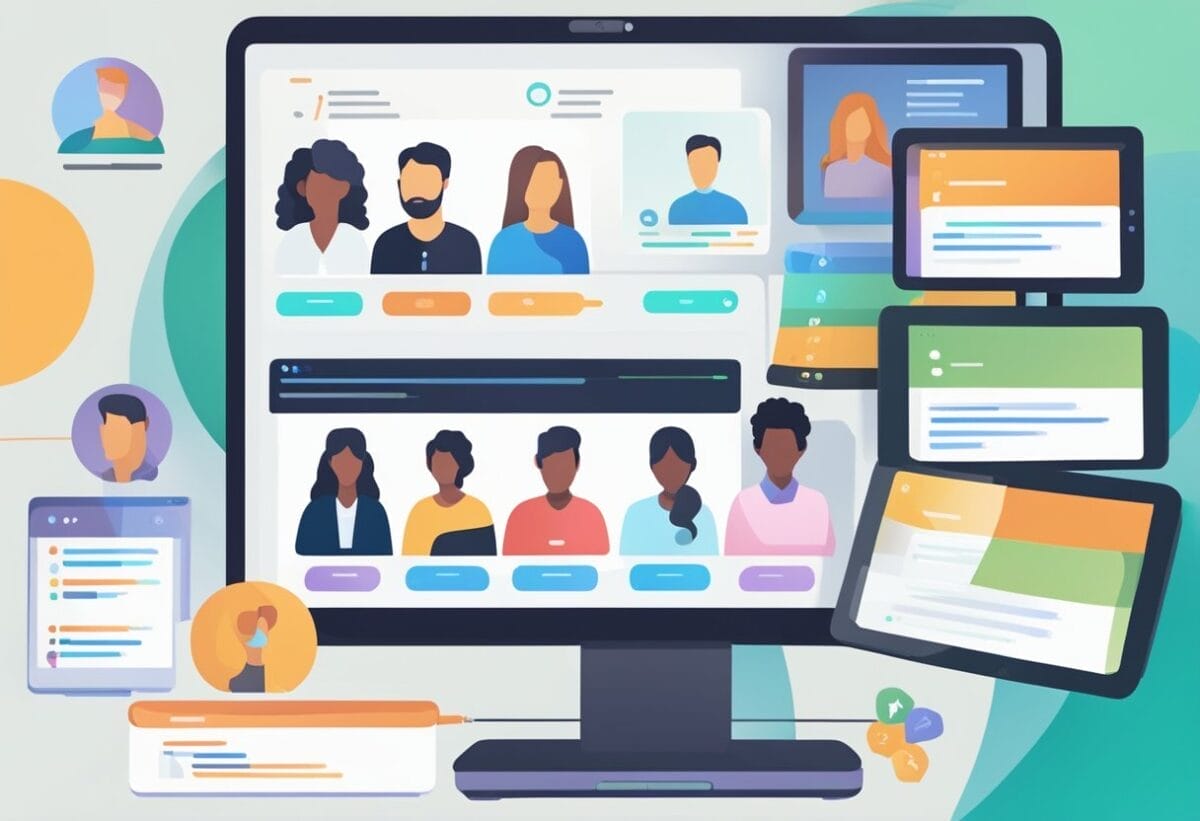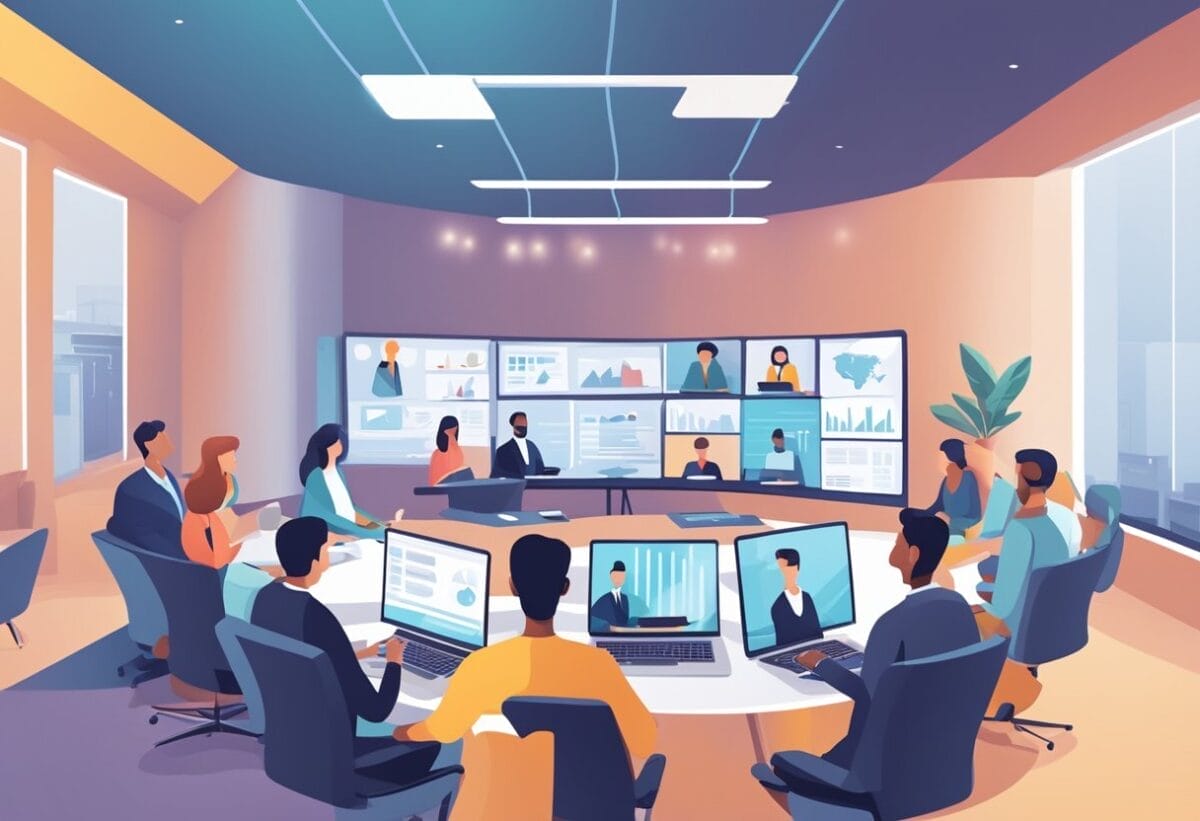Online meeting is not just about clear communication, but also a way to improve work productivity and building rapport with stakeholders. With technological advancements and the shift to more flexible work arrangements, the ability to meet virtually becomes the foundation of success in the digital landscape.
From basic teleconferencing that utilizes audio-only calls to more complex web conferencing that supports audio, video, and content sharing, the variety of virtual meeting formats is expansive.
KEY TAKEAWAYS
- Online meetings facilitate collaboration in flexible work arrangements.
- Different types of virtual meetings cater to varying communication needs.
- Choosing the right meeting type is essential for effective remote work.
What is an Online Meeting?
An online meeting connects individuals in different locations using the internet. This virtual space is essential for remote and hybrid working models. It is a web conference, where you can engage in dialogue, share screens, and collaborate in real time, regardless of geographical barriers.
Tools for online meeting ranges from enterprise meeting software for large firms to simpler online meeting solutions for smaller teams allow for tailored experiences that match the specific requirements of the meeting’s purpose.
With online meeting, it offers the flexibility of attending a meeting from anywhere, without travel costs and time loss, makes it a productive tool for business communication.
Teleconferencing or Audio Conferencing (Audio only)

When you think of virtual meetings, teleconferencing using audio might seem traditional, but it’s a highly effective way to connect with others without the need for high-tech setups. This method focuses on simplicity, making use of phone calls to bring people together, often in a conference room setting.
Pros of Teleconferencing
- Simplicity: You can join a teleconference with just a phone, making it accessible to anyone, anywhere.
- Convenience: Without the need for video, you can participate in a call without worrying about your environment or appearance.
Cons of Teleconferencing
- Limited Engagement: Without visual cues, it’s harder to maintain participants’ attention and gauge their responses.
- Challenges in Communication: Important non-verbal cues like facial expressions and gestures are missing, which can lead to misunderstandings.
Tips for Teleconferencing
- Prepare a Clear Agenda: Send out an agenda in advance to ensure your call is focused and efficient.
- Use Roll Call: Regularly check who is on the line to keep everyone engaged and accountable during the meeting.
Video Conferencing (Audio and Video)

Video conferencing integrates audio and video to enable real-time communication among participants, regardless of their location. It captures not only vocal but also visual cues.
Pros of Video Conferencing
- Enhanced Communication: You benefit from seeing facial expressions and body language, which can enhance understanding and rapport.
- Accessibility: Platforms like Zoom and Microsoft Teams allow you to join meetings from anywhere, increasing participation.
Cons of Video Conferencing
- Technical Issues: Disruptions due to poor internet connectivity can impede the flow of communication.
- Videoconference Fatigue: Continuous engagement in video meetings can lead to exhaustion, as identified in a conceptual analysis.
Tips for Video Conferencing
- Optimize Your Setup: Ensure good lighting and minimal background noise before joining a video conference.
- Stay Engaged: Practice active listening and maintain eye contact by looking at the camera.
Web Conferencing (Audio, Video and Content sharing)

Web conferencing tools like Zoom and Microsoft Teams have revolutionized how you meet and collaborate. They allow the sharing of not only voice and video but also content in real-time.
Pros of Web Conferencing
- Accessibility: You can join a web conference from anywhere in the world with an internet connection.
- Full Engagement: Video conferencing enables you to observe facial expressions and body language, key non-verbal cues that enhance understanding and communication.
Cons of Web Conferencing
- Technical Issues: Issues like poor internet connectivity or software problems can interrupt meetings.
- Video Fatigue: Regular video conferencing can lead to exhaustion from constant engagement and being on-camera, often termed “Zoom fatigue.”
Tips for Web Conferencing
- Prepare Your Space: Ensure that your space is quiet and well-lit. A professional background can make a substantial difference.
- Balance Engagement: Turn off your camera from time to time if video fatigue sets in, but remain audible to keep engaged.
Webinars (Host and Attendees)

Webinars allow you to reach a large audience through scheduled programming, focused on engaging content delivery and interaction. These online events can be live or prerecorded, offering the flexibility to suit diverse business needs.
Pros of Webinars
- Broad Reach: You can present to hundreds, if not thousands, of participants globally.
- Engagement Tools: Polls, Q&A sessions, and chat features enhance interaction with your participants.
- Cost-Effective: Save on venue and travel costs while delivering impactful presentations.
- Recording Capability: Allows for on-demand access, expanding the lifespan of your content.
Cons of Webinars
- Technical Issues: Connectivity problems can disrupt the flow and professionalism of your webinar.
- Less Personal: Despite engagement tools, webinars can feel impersonal and distant compared to face-to-face meetings.
- Participant Distractions: Attendees at home or in busy environments may be easily distracted.
- Scheduling Conflicts: Coordinating a time that works for a global audience can be challenging.
Tips for Webinars
- Select the Right Webinar Software: Your platform should be reliable and feature-rich to enhance the webinar experience.
- Schedule Thoughtfully: Consider time zones and potential conflicts to maximize attendance.
- Rehearse: Practice with your tools and content to ensure a smooth presentation.
- Engage Your Audience: Use interactive elements to maintain attention and provide value.
Virtual Team Meetings (Remote and Hybrid Work)

Virtual team meetings offer a platform for remote teams to collaborate and communicate effectively. These meetings utilize online tools to connect team members who are not in the same location, enabling them to work together in real-time or asynchronously.
Pros of Virtual Team Meetings
- Enhanced Flexibility: You can join these meetings from anywhere, giving you the flexibility to work from different locations.
- Cost-Effective: These meetings can significantly reduce travel expenses and time, as they eliminate the need to meet in person.
Advantages for Collaboration
- With virtual team meetings, you can easily share documents and utilize real-time editing features, enhancing collaboration among team members.
- They also pave the way for efficient brainstorming sessions with tools like digital whiteboards that allow immediate feedback and idea sharing.
Cons of Virtual Team Meetings
- Technical Issues: Connectivity problems can interrupt meetings, and not all team members may be well-versed in using digital tools.
- Lack of Personal Interaction: The absence of face-to-face communication can hinder rapport building among team members.
Challenges in Team Dynamics
- It can be challenging to ensure that all team members are engaged during a virtual meeting, potentially affecting the meeting’s productivity.
- Without physical cues, interpreting reactions and maintaining the team’s morale can be more difficult.
Tips for Virtual Team Meetings
- To conduct successful virtual team meetings, ensure you have a clear agenda and objectives. This will keep the meeting focused and efficient.
- Choose the right meeting software that fits your team’s needs. This will help facilitate smooth one-on-one interactions and group discussions.
- Start with a quick check-in to establish a connection with your team members. This makes the meeting more personal and friendly.
- Encourage participation by asking for input from each team member. This ensures everyone’s voice is heard, thus fostering a collaborative environment.
Hybrid Meetings (Physical and Virtual)

Hybrid meetings combine the traditional in-person meeting experience with the inclusion of remote workers, bringing together the best of both worlds.
Pros of Hybrid Meetings
- Flexibility: You can choose to attend in person at a physical location or virtually. This accommodates different schedules and locations.
- Wider Reach: Invite participants globally without the constraints of travel or space. This maximizes attendance and diversity of input.
Cons of Hybrid Meetings
- Technical Challenges: Ensuring seamless integration of virtual and in-person components can be complex.
- Engagement Disparity: Remote participants might feel less engaged when compared to those who are physically present.
Tips for Hybrid Meetings
- Prepare meticulously to address technical issues beforehand. This ensures all participants have a smooth experience.
- Encourage interaction between all attendees, regardless of their location. This helps maintain high engagement levels.

Read Also:
- How to Write a Professional Email At Work (with Examples)
- How to Reply to a Meeting Invitation Request (with Examples)
- 23 Email Etiquette: Professional Communication in Remote Workplace
- How to Do Online Meeting Follow-Up [+12 Follow-Up Meeting Email Templates]
- How to Boost Engagement During Online Meetings During (5 Meeting Engagement Strategies)
Join over 11,000+ achievers who are committed to achieving their career goals!






